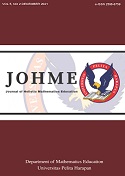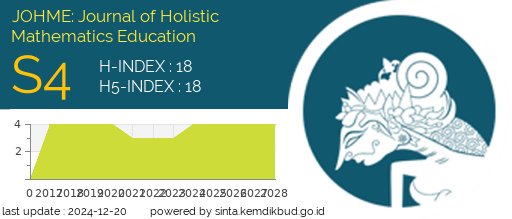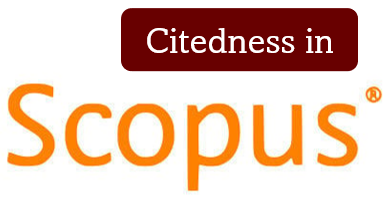ANALISIS KEMAMPUAN MENYELESAIKAN MASALAH MATEMATIKA SOAL HOTS DITINJAU DARI KEPERCAYAAN DIRI PADA SISWA KELAS VIII SMP NEGERI 5 PALLANGGA [AN ANALYSIS OF STUDENTS’ ABILITY TO SOLVE HOTS PROBLEMS BASED ON SELF-CONFIDENCE LEVELS IN A GRADE 8 MATHEMATICS CLASS AT SMP NEGERI 5 PALLANGGA]
DOI:
https://doi.org/10.19166/johme.v5i2.4543Kata Kunci:
mathematics problems, HOTS, higher order thinking skills, self-confidence, masalah matematika, kepercayaan diriAbstrak
This study describes students' ability to solve HOTS problems according to their self-confidence level in a grade 8 class at a junior high school in Pallangga. The type of research used is descriptive qualitative research. The research procedure includes the preparation, implementation, and analysis stages of research results. The subjects in the study were 3 grade 8 students at SMP Negeri 5 in the district of Pallangga. The subjects were selected by giving a questionnaire to all grade 8 students to select students who had high self-confidence, moderate self-confidence, and low self-confidence. The research refers to the four stages of the ability to solve mathematical problems based on Polya's steps, namely: understanding the problem, planning problem-solving strategies, carrying out calculations, and evaluating the results of problem-solving. The research instrument was a self-confidence questionnaire, an ability test to solve HOTS math problems based on Polya's steps, and interview guidelines. The results showed that there were differences in the ability to solve mathematical HOTS questions based on Polya's steps by the three selected subjects. The results showed that subjects with high self-confidence and moderate self-confidence were able to meet the indicators of understanding the problem, while subjects with low self-confidence were unable to meet the indicators of understanding the problem. At the stage of planning a problem-solving strategy, subjects with high self-confidence and moderate self-confidence were able to meet the indicators, while subjects with low self-confidence were unable to meet the indicators. At the stage of carrying out calculations, subjects with high self-confidence were able to meet the indicators, while subjects with moderate self-confidence and low self-confidence were unable to meet the indicators. And at the stage of re-examining the results of problem-solving, subjects with high self-confidence were able to meet the indicators, while subjects with moderate self-confidence and low self-confidence were unable to meet the indicator.
BAHASA INDONESIA ABSTRACT: Penelitian ini bertujuan untuk mendeskripsikan kemampuan menyelesaikan masalah matematika soal HOTS ditinjau dari kepercayaan diri pada siswa kelas VIII SMP Negeri 5 Pallangga. Jenis penelitian adalah penelitian deskriptif kualitatif. Prosedur penelitian meliputi persiapan, pelaksanaan dan tahap analisis hasil penelitian. Subjek dalam penelitian adalah 3 orang siswa kelas VIII SMP Negeri 5 Pallangga. Subjek dipilih dengan memberikan angket kepada seluruh siswa kelas VIII untuk memilih siswa yang memiliki kepercayaan diri tinggi, kepercayaan diri sedang, dan kepercayaan diri rendah. Penelitian mengacu pada empat tahap kemampuan menyelesaikan masalah matematika berdasarkan langkah Polya yaitu: memahami masalah, merencanakan strategi pemecahan masalah, melaksanakan perhitungan, dan memeriksa kembali hasil penyelesaian masalah. Instrumen penelitian adalah angket kepercayaan diri, tes kemampuan menyelesaikan masalah matematika soal HOTS berdasarkan langkah Polya, dan pedoman wawancara. Hasil penelitian menunjukkan bahwa terdapat perbedaan kemampuan menyelesaikan masalah matematika soal HOTS berdasarkan langkah Polya oleh ketiga subjek yang dipilih. Berdasarkan hasil penelitian diperoleh bahwa subjek dengan kepercayaan diri tinggi dan kepercayaan diri sedang mampu memenuhi indikator memahami masalah, sementara subjek dengan kepercayaan diri rendah tidak mampu memenuhi indikator memahami masalah. Pada tahap merencanakan strategi pemecahan masalah, subjek dengan kepercayaan diri tinggi dan kepercayaan diri sedang mampu memenuhi indikator, sementara subjek dengan kepercayaan diri rendah tidak mampu memenuhi indikator. Pada tahap melaksanakan perhitugan, subjek dengan kepercayaan diri tinggi mampu memenuhi indikator, sementara subjek dengan kepercayaan diri sedang dan kepercayaan diri rendah tidak mampu memenuhi indikator. Dan pada tahap memeriksa kembali hasil penyelesaian masalah, subjek dengan kepercayaan diri tinggi mampu memenuhi indikator, sementara subjek dengan kepercayaan diri sedang dan kepercayaan diri rendah tidak mampu memenuhi indikator.
Referensi
Adnyani, L. P. W., Kurniawan, I., & Pinahayu, E. A. R. (2018). Development of-thinking instrument in mathematics problems solving based on logical mathematics intelligence. Journal of Research and Advances in Mathematics Education, 3(1), 1-12. https://dx.doi.org/10.23917/jramathedu.v3i1.5201
Akib, I., & Khaeruddin. (2008). Belajar dan pembelajaran MIPA. Makassar, Indonesia: Lembaga Perpustakaan dan Penerbitan Unismuh Makassar.
Anderson, L. W., & Krathwohl, D. R. (2001). A taxonomy for learning, teaching, and assessing: A revision of Bloom’s taxonomy of educational objectives. New York, NY: Addison Wesley Longman.
Badjeber, R., & Purwaningrum, J. P. (2018). Pengembangan higher order thinking skills dalam pembelajaran matematika di smp. Guru Tua (Jurnal Pendidikan dan Pembelajaran), 1(1), 36-43. https://doi.org/10.31970/gurutua.v1i1.9
Butkowski, J., Corrigan, C., Nemeth, T., & Spencer, L. (1994). Improving student higher-order thinking skills in mathematics. Mathematics Education Research, 1-331. Retrieved from https://files.eric.ed.gov/fulltext/ED383526.pdf
Coffman, T. (2013). Engaging students through inquiry-oriented learning and technology. Lanham, MD: Rowman & Littlefield Education.
Daniel, W.W. (1980). Statistika nonparametrik terapan. Jakarta, Indonesia: Gramedia.
Dirgantoro, K. P. S., & Soesanto, R. H. (2021). Peran guru Kristen dalam menuntun siswa memandang matematika [The role of Christian teachers in guiding students to view mathematics]. JOHME: Journal of Holistic Mathematics Education, 5(1), 114-124. https://dx.doi.org/10.19166/johme.v5i1.3363
Fauziah, R., Maya, R., & Fitrianna, A. Y. (2018). Hubungan self confidence terhadap kemampuan pemecahan masalah matematis siswa SMP. Jurnal Pendidikan Matematika Inovatif, 1(5), 881-886. http://dx.doi.org/10.22460/jpmi.v2i5.p329-336
Fitriani, N. (2013). Penerapan pendekatan PMRI secara berkelompok untuk meningkatkan kemampuan pemecahan masalah matematis dan self confidence siswa SMP. Jurnal Pendidikan Sigma Dikdaktik, 2(1), 176-183. http://dx.doi.org/10.22460/jiml.v3i3.p169-177
Halim, S. N. H., Mahmud, R. S., Tahir, S. R., Gaffar, A., Wulandari, S., & Trisnowali, A. (2021). Analyzing misconception of exponent for high school in Makassar. Proceedings of the 1st International Conference on Mathematics and Mathematics Education (ICMMEd 2020), 550, 1-4. https://doi.org/10.2991/assehr.k.210508.100
Hasyim, M., & Andreina, F. K. (2019). Analisis high order thinking skill (HOTS) siswa dalam menyelesaikan soal open ended matematika. Fibonacci (Jurnal Pendidikan Matematika dan Matematika), 5(1), 55-64. https://dx.doi.org/10.24853/fbc.5.1.55-64
Hendriana, H., Rohaeti, E. E., & Sumarmo, U. (2017). Hard skills dan soft skills matematik siswa. Bandung, Indonesia: PT Refika Aditama.
Hulukati, W. (2016). Pengembangan diri siswa SMA. Gorontalo, Indonesia: Ideas Publishing.
Joyce, B., Weil, M., & Showers, B. (1992). Models of teaching. Boston, MA: Allyn and Bacon.
Mandini, G. W., & Hartono, H. (2018). Analisis kemampuan menyelesaikan soal HOTS model TIMSS dan kepercayaan diri siswa sekolah menengah pertama. Pythagoras: Jurnal Pendidikan Matematika, 13(2), 148-157. https://doi.org/10.21831/pg.v13i2.21234
Megawati, Wardani, A. K., & Hartatiana. (2020). Kemampuan berpikir tingkat tinggi siswa SMP dalam menyelesaikan soal matematika model PISA. Jurnal Pendidikan Matematika, 14(1), 15-24. https://doi.org/10.22342/jpm.14.1.6815.15-24
Melyana, A. & Pujiastuti, H. (2020). Pengaruh kepercayaan diri terhadap kemampuan bepikir kritis matematis siswa SMP. Jurnal Pembelajaran Matematika Inovatif, 3(3), 239-246. Retrieved from https://journal.ikipsiliwangi.ac.id/index.php/jpmi/article/view/4227/1587
Mitri, H. (2016). Analisis pembelajaran berpikir tingkat tinggi pada mata pelajaran ekonomi di SMAN 8 Yogyakarta [Undergraduate Thesis: Unpublished]. Universitas Sanata Dharma. Retrieved from https://repository.usd.ac.id/6445/
Nur, A. S., Waluya, S. B., Rochmad, R., & Wardono, W. (2020). Contextual learning with ethnomathematics in enchancing the problem solving based on thinking levels. JRAMathEdu (Journal of Research and Advances in Mathematics Education), 5(3), 331-344. https://dx.doi.org/10.23917/jramathedu.v5i3.11679
Nufus, H., Duskri, M., & Bahrun. (2018). Mathematical creative thinking and student self-confidence in the challenge-based learning approach. Journal of Research and Advances in Mathematics Education, 3(2), 57-68. https://dx.doi.org/10.23917/jramathedu.v3i2.6367
Nursyahidah, F., Saputro, B. A., & Rubowo, M. R. (2018). A secondary student's problem solving ability in learning based on realistic mathematics with ethnomathematics. JRAMathEdu (Journal of Research and Advances in Mathematics Education), 3(1), 13-24. https://dx.doi.org/10.23917/jramathedu.v3i1.5607
Patandung, A. B., & Saragih, M. J. (2020). Peran guru Kristen dalam menumbuhkembangkan kepercayaan diri siswa dalam pembelajaran matematika [The role of Christian teachers in developing students’ confidence in mathematics]. JOHME: Journal of Holistic Mathematics Education, 3(2), 180-199. https://dx.doi.org/10.19166/johme.v3i2.1972
Pitasari, R. G. (2014). Perbedaan kemampuan pemecahan masalah matematis siswa antara pembelajaran kontekstual rangka bermodifikasi dengan pembelajaran konvensional [Undergraduate Thesis: Unpublished]. Universitas Pendidikan Indonesia.
Purnama, S., & Mertika. (2018). Analisis kemampuan pemecahan masalah siswa ditinjau dari self confidence. Journal of Educatinal Review and Research, 1(2), 59-63. http://dx.doi.org/10.26737/jerr.v1i2.1619
Riadi, A., & Retnawati, H. (2014). Pengembangan perangkat pembelajaran untuk meningkatkan HOTS pada kompetensi bangun ruang sisi datar. Pythagoras: Jurnal Pendidikan Matematika, 9(2), 126-135. https://doi.org/10.21831/pg.v9i2.9074
Roebyanto, G., & Harmini, S. (2017). Pemecahan masalah matematika untuk PGSD. Bandung, Indonesia: PT Remaja Rosdakarya.
Sahyudin. (2014). Meningkatkan kemampuan pemecahan masalah matematis dan berpikir kreatif siswa melalui model pembelajaran diskursus multi representasi (DMR) [Thesis]. Universitas Pendidikan Indonesia. Retrieved from http://repository.upi.edu/11783/
Santrock, J. W. (2004). Psikologi pendidikan. Jakarta, Indonesia: Kencana.
Saraswati, P. M. S., & Agustika, G. N. S. (2020). Kemamuan berpikir tingkat tinggi dalam menyelesaikan soal HOTS mata pelajaran matematika. Jurnal Ilmiah Sekolah Dasar, 4(2), 257-269. http://dx.doi.org/10.23887/jisd.v4i2.25336
Sumaryanta. (2018). Penilaian HOTS dalam pembelajaran matematika. Indonesian Digital Journal of Mathematics and Education, 8(8), 500-509. Retrieved from http://idealmathedu.p4tkmatematika.org/articles/IME-V5.8-02-Sumaryanta.pdf
Tambunan, S. J., Sitinjak, D. S., & Tamba, K. P. (2019). Pendekatan matematika realistic untuk membangun kemampuan pemecahan masalah matematis siswa kelas XI IPS pada materi peluang. JOHME: Journal of Holistic Mathematics Education, 2(2), 119-130. https://dx.doi.org/10.19166/johme.v2i2.1691
Tamsir, T., Silalahi, D. W., & Soesanto, R. H. (2019). Upaya meningkatkan kemampuan pemecahan masalah soal non-rutin pada materi persamaan dan pertidaksamaan linear satu variabel dengan penerapan metode peer tutoring. JOHME: Journal of Holistic Mathematics Education, 3(1), 96-107. https://dx.doi.org/10.19166/johme.v3i1.927
Tiro, M. A. (2010). Cara efektif belajar matematika. Makassar, Indonesia: Andira Publisher.
Tresnawati, H. W., & Rohaeti, E. R. (2017). Kemampuan berpikir kritis matematis dan kepercayaan diri SMA. Pasundan Journal of Resesarch in Mathematics Learning and Education, 2(2), 39-45. http://dx.doi.org/10.23969/symmetry.v2i2.616
Walgito, B. (2004). Pengantar psikologi umum. Yogyakarta, Indonesia: Andi.
Wena, M. (2009). Strategi pembelajaran inovatif kontemporer: Suatu tinjauan konseptual operasional. Jakarta, Indonesia: Bumi Aksara.
Wijaya, A. (2012). Pendidikan matematika realistik (Suatu alternatif pendekatan pembelajaran matematika). Yogyakarta, Indonesia: Graha Ilmu.
Yates, S. M. (2002). The influence of optimism and pessimism on student achievement in mathematics. Mathematics Education Research Journal, 14(1), 4-15. https://doi.org/10.1007/BF03217113
Zulkarnain, I. (2015). Kemampuan pemecahan masalah dan kemampuan komunikasi matematika siswa. Jurnal Formatif, 5(1), 42-54. http://dx.doi.org/10.30998/formatif.v5i1.164Unduhan
Diterbitkan
Cara Mengutip
Terbitan
Bagian
Lisensi
Authors who publish with this journal agree to the following terms:
1) Authors retain copyright and grant the journal right of first publication with the work simultaneously licensed under a Creative Commons Attribution License (CC-BY-SA 4.0) that allows others to share the work with an acknowledgement of the work's authorship and initial publication in this journal.
2) Authors are able to enter into separate, additional contractual arrangements for the non-exclusive distribution of the journal's published version of the work (e.g., post it to an institutional repository or publish it in a book), with an acknowledgement of its initial publication in this journal.
3) Authors are permitted and encouraged to post their work online (e.g., in institutional repositories or on their website). The final published PDF should be used and bibliographic details that credit the publication in this journal should be included.”










